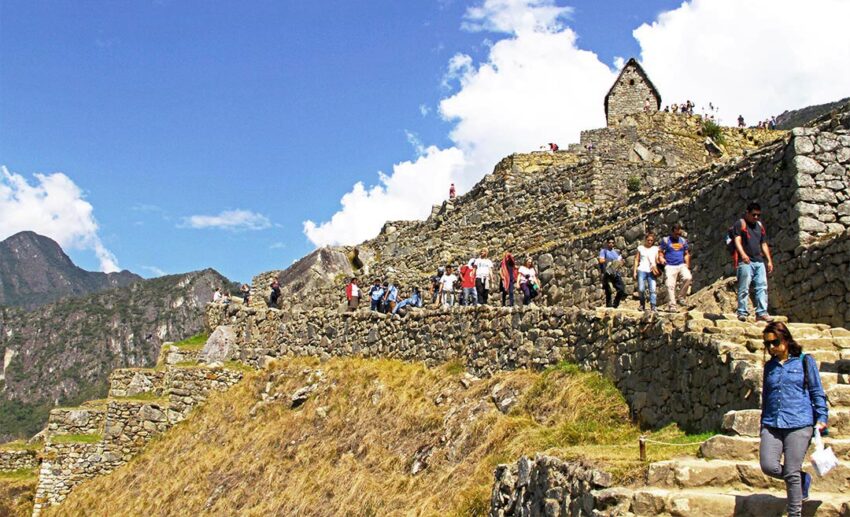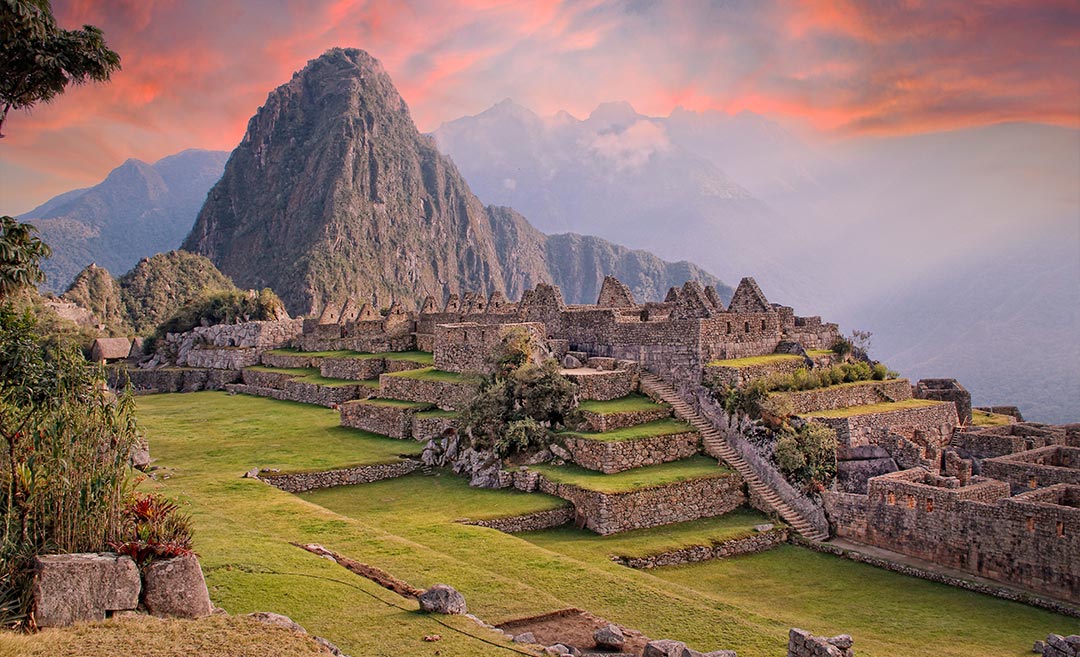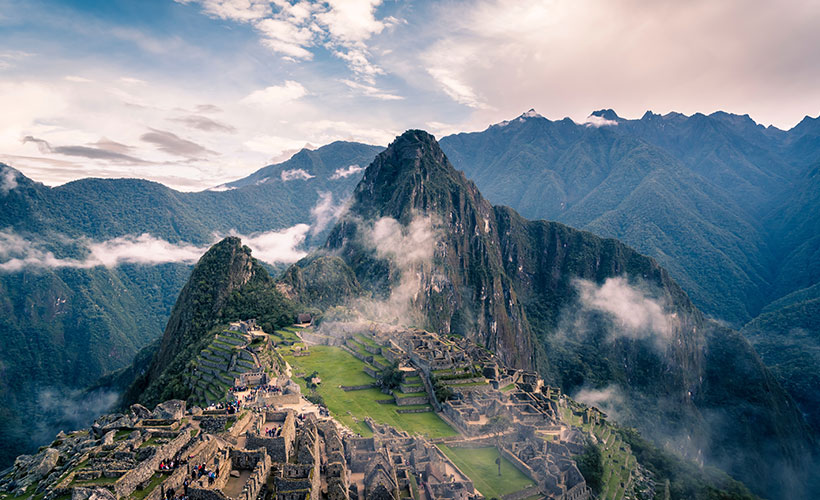Machu Picchu is one of the world’s most recognisable archaeological sites and one that attracts global travellers for its sheer scale and grandeur. In a remote mountainous location, this mighty centre of Inca civilisation is recognised as a UNESCO World Heritage Site.
Visitors fly from Lima, the Peruvian capital, to Cusco before travelling to Machu Picchu. Many spend time in the Sacred Valley, where other heritage sites, like Ollantaytambo, close to the banks of the Urubamba River, will especially appeal to those who love culture and history.
A spiritual home
Apu is the name the Incas gave to the mountain spirits, and their protective forces were responsible for the agricultural success of their civilisation and the general well-being of those who lived here.
Known as the Historic Sanctuary of Machu Picchu, this UNESCO heritage site is a fascinating feat of construction and engineering. It consists of structures erected from massive stone blocks transported over long distances to their current site, perched high in the Andes.

Visitors are constantly reminded that these massive stone blocks were moved from other sites and then aligned without mortar and with such accuracy to ensure they have remained unmoved for centuries.
Machu Picchu, covering over 32,600 ha, is recognised for its outstanding natural and cultural assets, including the surrounding foothills, mountainous peaks, and deep valleys comprising the impressive archaeological monument, La Ciudadela, or the Citadel.

This mountainous settlement, established in the 15th century, was abandoned when the Spaniards conquered the land in the 16th century, and it only came to the attention of outsiders in 1911. Some 200 stone structures are positioned on a site that had religious, agricultural, ceremonial, and astronomical importance to the local people.
One of the things that fascinated me was that experts still debated many aspects of Inca life, but most recognised the intricate relationship the people had with their surroundings.
Some archaeologists suggest that Machu Picchu was a fortress, an astrological site, a reflective retreat, or a centre of religion. Still, whatever it was, its people made conscious decisions to move mountains to erect the grand stone structures.

The journey to Machu Picchu
Visitors can travel from Cusco to Machu Picchu by various means, with the most comfortable being in the luxurious and exclusive railway cars of the Hiram Bingham.
American archaeologist Professor Hiram Bingham ‘discovered’ Machu Picchu (which means ‘old peak’) in 1911, and the train that now transfers well-heeled visitors from Cusco to Machu Picchu is named after him.
It has a dining car, a bar car, and an observatory, where passengers can admire the scenery in the open air while sipping a pisco sour cocktail or listening to musicians playing in the bar car.
Its morning departure from Poroy Station near Cusco heads to Machu Picchu Station before reversing its journey in the late afternoon.

I travelled both ways in one day and enjoyed an excellent selection of beverages, including local Peruvian wines, beers, and pisco sour, the national cocktail. Passengers on the journey to Machu Picchu enjoy a gourmet lunch as they pass Ollantaytambo, while dinner is served on the early evening return trip.

The Hiram Bingham train, with rail cars, modelled on Pullman carriages from the 1920s, operates daily except on the last Sunday of each month. All-inclusive fares include coach transfers to and from Cusco to Poroy Station, meals, beverages, the train to Machu Picchu Station, a bus to the heritage site, entry fees and a guide, and a refreshing post-tour cocktail at Belmond Sanctuary Lodge.
Passengers who want to spend more time at Machu Picchu can stay overnight, and for rail guests who have travelled there in the luxurious surrounds of the train, this means staying at Belmond Sanctuary Lodge.
Supercharged heritage
Most visitors to this part of Peru also spend time in Cusco and the Sacred Valley. Attractions in the Sacred Valley, or the Urubamba River Valley, include the Inca ruins of Ollantaytambo, although there are other tourist sites to visit.
Cusco Airport is the gateway, and it wasn’t long before I began to explore the city’s narrow alleyways, grand plazas, and impressive public buildings that are protected within the City of Cusco’s UNESCO World Heritage Site.

Even on the simplest of slopes, I was huffing and puffing, but I used my rest time to photograph the sights while catching my breath. At an altitude of 3,400m, altitude sickness (referred to locally as soroche) is an important consideration for all visitors to this part of the world. Despite most visitors arriving via Cusco, it isn’t the best place to acclimatise before travelling to Machu Picchu, as the latter is located at a lower altitude of 2,430m.
Visitors need to take it slowly, drink coca tea, and rest, with the only solution for those suffering from altitude sickness being to relocate to a lower altitude. To avoid this, some tourists start their journey in the Sacred Valley and then visit Machu Picchu before completing their Andean tour in Cusco.
Cusco was home to the Incas before the Spanish colonised the land, and there’s evidence of both cultures, with the Qorikancha housing Inca foundations alongside the Convent of Santo Domingo.
A highlight of my time in Cusco was a visit to the centrally located San Pedro Mercado. Everyone loves a market, and this one is up there with the best for its variety, colour, and vibrancy. Peru has a staggering 4,000 varieties of potatoes and over 50 types of corn (known here as choclo), making for very colourful vegetable stalls. While there were fruits I had never seen before, there were many familiar ones, and all were priced very cheaply. Some fascinating products included quinoa, chocolate, coffee, coca leaves, salt, and queso fresco (a Feta-like cheese). Many of the 230 stalls are operated by women in colourful traditional clothes and felt hats.

Plaza de Armas is typical of several open plazas in the city centre, with the ornate Cathedral of Cusco and Iglesia de la Compañía de Jesús (Church of the Society of Jesus) positioned in front of landscaped gardens.

Barrio de San Blas, with its narrow, winding alleyways, is another popular precinct in the city. Boutiques selling arts and crafts interspersed with bars and cafés create a lively area.
Insert Photo: Explore the narrow streets and alleyways in Cusco’s Barrio de San Blas neighbourhood.
Adventurous travellers will want to stay in Machu Picchu to spend several days exploring the archaeological site, Cusco, and the Sacred Valley, whereas armchair explorers will be content with just a half-day at Machu Picchu.
Machu Picchu travel tips
Getting there: There are no direct flights from Asia to Peru, so travellers have to transit somewhere on their journey, with the service provided by KLM Royal Dutch Airlines being good with a short layover in Amsterdam. KLM operates daily flights from Kuala Lumpur via Amsterdam Schiphol Airport, with the direct flight taking some 30 hours.

There are domestic flights from Lima to Cusco, and Machu Picchu is several hours from Cusco. Adventurous visitors can make the multi-day, 42-km, high-altitude walk on the Inca Trail or ride the famous Hiram Bingham train to Machu Picchu to admire this dramatic archaeological site perched high up in the Andes. The bus journey from Plaza de Armas in Cusco to Poroy Station takes 20 minutes. Ollantaytambo Station is 90 minutes away, while Machu Picchu Pueblo Station (or Aguas Calientes) is another 90 minutes away. From here, passengers travel to the heritage site by bus.

Visas: Malaysians don’t require a visa to enter Peru.

Where to stay: Belmond Palacio Nazarenas Cusco, Belmond Monasterio Cusco, Belmond Hotel Rio Sagrado (Sacred Valley), and Belmond Sanctuary Lodge Machu Picchu.
Useful rail websites: Hiram Bingham train and Perurail.
All images are by author unless specified otherwise.




